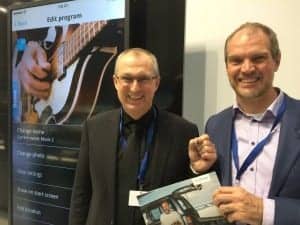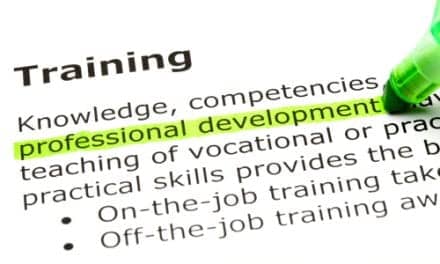Updated October 31, 2016
Approximately 7,800 acousticians and other hearing care professionals, as well as industry personnel, converged on the Deutsche Messe Hannover in Germany for EUHA 2016, the 61st Annual International Congress of Hearing Aid Acousticians, held October 19-20 by the European Union of Hearing Aid Acousticians (EUHA).

EUHA President Martin Blecker presents the EUHA Golden Badge of Honor—the organization’s highest honor—to Inge Steinl, the former managing director of FGH and VHI (today BVHI).
The EUHA Congress has gradually become the most important 3 days in the worldwide hearing healthcare calendar, with about 40% of its attendees coming from 88 countries outside of Germany. This year’s primary topics of discussion—both inside the crowded and lively exposition hall and in its large technical feature sessions—included the positive effects of amplification on cognition and healthy aging, as well as tinnitus remediation, new noise reduction technologies, hearing protection, remote programming and tele-practice, 2.4 GHz wireless streaming devices, and the continued forward retail integration of hearing aid manufacturers. The two main components of EUHA 2016 offered great variety: the EUHA Expo featured over 130 exhibitors, and the Congress’ scientific offerings included 37 feature sessions and 6 special workshops, presented by over 50 experts in the field. There were also several events, including the general meetings of EUHA, BIHA, and the annual Congress Get-Together.
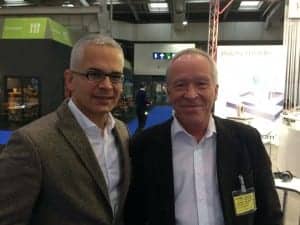
BVHI Chairman Dr Stefan Zimmer and EHIMA Executive Director Søren Hougaard pause for a moment in the busy Expo hall.
EUHA serves as the scientific, educational, and clinically oriented organization for hearing aid acousticians and is an independent affiliate with the Bundesinning der Hörgeräteakustiker (BIHA) which represents German acousticians in matters related to legislation, reimbursement, etc. A third organization, the Bundesverband der Hörgerate-Industries (BVHI, or German Assn of the Hearing Instruments Industries) works as the profession’s marketing arm within Germany (eg, similar the Better Hearing Institute in the US), promoting hearing awareness and the importance of hearing healthcare to consumers.
Setting the Tone: Hearing and Healthy Aging
This year’s educational component of the Congress was kicked off with equal measures of entertainment and science. Long-time EUHA President Martin Blecker serves as the general host of the Congress, and is often seated at stage-right during the scientific presentations so he can get the ball rolling and pepper presenters with questions and comments during the Q&A session. This year, after honoring several distinguished members of EUHA and the BIHA with special awards, Blecker introduced Gregor Widholm, founder of the Institute of Music Acoustics at the Vienna Music University. Widholm demonstrated to the audience several auditory illusions present in music and hearing, including octave matching, the influence of loudness on pitch perception, and unique facets of how the brain processes acoustic information.
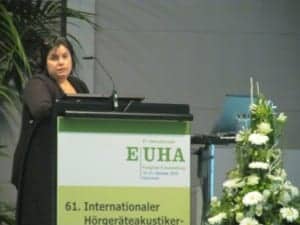
Helene Amieva, PhD, of the University of Bordeaux presented the feature session, “Hearing aids attenuate cognitive decine in elderly people with hearing loss.”
This was followed by two special presentations on hearing loss and its relationship to cognition and healthy aging. Héléne Amieva, PhD, of the University of Bordeaux, France, provided an overview of her group’s research, which looked at 25-year longitudinal data from the PAQUID study, and showed how hearing loss was associated with declines in scores of the mini mental state examination (MMSE), independent of age, gender, and education. The research also suggests that people in the study who used hearing aids had no difference in cognitive decline compared to controls.
Dr Amieva was followed by Nicholas Reed, AuD, (pictured at the top of the page) who is conducting research with Frank Lin, MD, PhD, at Johns Hopkins, studying the effects of hearing loss on a raft of possible hearing-related related problems, as well as the interactions between hearing loss, cognitive load, brain structure and size, social isolation, cognitive vitality, and physical function. Dr Reed concluded that, to his knowledge, no other field has found such a dramatic potential for late-life intervention; with hearing loss, research may ultimately show that it’s possible to intervene in a person’s care while in their 60s or 70s, possibly forestalling cognitive decline and/or lessening the risk of falls, improving walking speed/gate, and reducing hospital visits.
The scientific portion of EUHA had a total of 37 presentations, presented in half-hour sessions. Among the many varied and interesting topics during the 3 days were:
- A look at the new EarLens device was presented by long-time hearing aid researcher Brent Edwards, PhD, who detailed how the system works by using light instead of sound in the stimulation of the middle ear for wideband feedback-free amplification.
- New fitting and processing strategies for bimodal cochlear implants (ie, CI + hearing aid), were presented by Josef Chalupper, PhD, of Advanced Bionics.
- Jonas Frenkel provided new data on perceived listening effort, comparing methods of various studies and why it may be difficult to compare some findings in terms of listening effort, general fatigue, and memory-related issues.
- The Association of Electrical, Electronic, and Information Technologies (DKE), as described by Hendrik Husstedt of Lübeck, is studying hearing aid program algorithms and their reliability for correctly identifying listening situations.
- A description by engineer Horst Warncke of the latest noise reduction system from Oticon which is said to reduce loudness and allow for “selective listening” beyond traditional directional microphones.
- Thomas Steffens explained why the LTASS has significant limitations that result in the over-estimation of audibility, with consequential negative effects on the speech intelligibility index (SII).
- Results from a study by Barry Freeman, PhD, and colleagues at ZPower, on battery drain comparisons when using various hearing aid functions, like wireless streaming, and how the datasheets from hearing aid manufacturers may have little relevance to the actual power consumption in hearing aids.
- A presentation by Jürgen Tchorz of Lübeck about fitting options and patient benefit of frequency-lowering algorithms.
Europe: A Positive Outlook for Hearing Healthcare
It doesn’t take long at US hearing healthcare conferences to sense anxiety among professionals who dispense hearing aids. Big box retailers, PSAPs, and independent bodies like PCAST and NAS proposing significant changes to hearing regulations are only a few of the weighty issues confronting the US market. It should be acknowledged that European dispensing professionals deal with many of the same concerns, including (sometimes radical and unexpected) changes in the reimbursement systems, lower average sales prices (ASP), disruptive technology, and the continued forward consolidation (particularly, in Germany, Sonova’s purchase of AudioNova) of hearing aid retail by manufacturers.
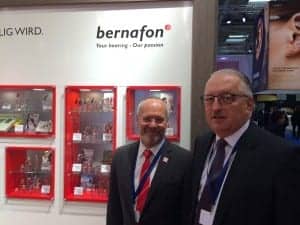
Bernafon’s Bruno Keller and Erich Spahr stand in front of a hearing aid history exhibit that celebrates the company’s 70th anniversary.
However, in general, EUHA 2016 attendees exuded confidence and exuberance about the future of the hearing healthcare market and their place in it. The European socialized medicine system, in most cases, provide for the public funding of at least basic-level hearing aids, eliminating the need for PSAP-type devices aimed at amplification for those with hearing loss, and Big Box and mass retailers also have not entered the European hearing care market. With a few notable exceptions, people in Europe can get free basic hearing aids. For example, since November 2013, Germany’s healthcare system reimburses up to €650 per hearing aid or €1300 per pair (US$700 and $1400 respectively) every 6 years; anything above this is paid out-of-pocket at the consumer’s discretion. There are now numerous product options to choose from in the low end because, prior to November 2013, the reimbursement rate was only €360 per aid. Some independent hearing aid dispensers contend that the majority of the basic/low-end purchases (€650/aid), which make up about one-quarter of the German market, are primarily serviced by specific chains that have the scale of economy to specialize in these sales. Most successful independents (about half the market in Germany), by contrast, focus their efforts on value-added diagnostics, services, and aural rehabilitation, with a subsequent emphasis on individualized fittings and mid- to high-technology aids.
Similarly, while it is generally acknowledged that “hearables” pose a risk of becoming a future technology disrupter for acousticians, most independents eye these devices as an equal measure of threat and opportunity. In all likelihood, “hearable features” that would monitor data, such as heart rate, positional changes, etc, would most likely find their way into the high-end technology devices.
As pointed out in many of the media and analysts’ presentations held by William Demant Holding (WDH), GN, and Amplifon (and Sonova, the day prior to the Congress) during EUHA 2016, there is a persuasive investment case for the worldwide hearing aid market, and it’s not only because of the impressive demographics of global aging (for which Germany is something of a poster-child…or grandparent). Projections for future worldwide annual unit growth are in the 4-5% range, albeit with a 1-2% erosion in ASPs. However, in more recent years, both Europe and the United States have enjoyed robust unit growth rates due to different reasons, including the rise of Big Box retailers in the US, changes in dispensing rules and reimbursement in Europe, and more office openings and overall strong performance by larger dispensing networks.
In Western Europe, according to long-time industry observer Tony Grant-Salmon,1 hearing aid unit sales were estimated to increase by 4.1% in 2015 against a strong base of 12.2% in 2014. When paired with US sales (a 7.1% increase in 2015 and on-pace for a 10% increase in 2016), the industry is looking very healthy. Grant-Salmon estimates that the European market has grown by about 40% compared to 28% for North America during the last 5 years. As previously noted, ASPs are falling both in the US and Europe, so the value of the market is growing at a slower pace than that indicated by unit volume.
More Buzz from EUHA 2016
Here are several other factors that gave EUHA 2016 an upbeat vibe, as well as some key topics that had attendees and market experts talking:
- Industry finally clicking on all 6 cylinders. All of the global “Big 6” manufacturers appear to be doing well, and are in full pursuit of new technological horizons. In the past years, there have been several disruptions that have derailed one manufacturer after another, particularly when paring R&D expenses in advance of M&A activity. This is certainly not the case at present; all the major global players appear to have strong diverse product portfolios and are investing in R&D to get them to the next level. Although it could be argued that the legal issues embroiling Starkey have led to the exodus of several important staff members, the company’s sales and technology pipeline appears to be unaffected by the turmoil; its Halo2 and other products have been well received.
- 2.4 GHz and wireless connectivity. All of the hearing aid manufacturers have moved to one of two major systems in offering 2.4 GHz and made-for-iPhone (MFi) technology. GN (ReSound) and Sonova (Phonak, Unitron & Hansaton) offer direct 2.4 GHz hearing aids (without an interface device), while WDH (Oticon, Bernafon, & Sonic), Sivantos (Signia/Siemens & Rexton), Starkey, and Widex offer 2.4 GHz using some form of dual-wireless technology. Both the direct and the dual-wireless systems have unique trade-offs (eg, simplicity vs power consumption, etc), but all appear to be fully capable of providing exceptional connectivity for the end user. The industry’s product development is also focusing on made-for-Android (MFA) hearing aids, several of which are expected to be introduced in 2017.
- Rechargeable hearing aids. Sonova and Sivantos have incorporated rechargeable batteries into their new hearing aid designs using lithium-ion technology, the same battery chemistry found in cell phones. Reports suggest that Starkey will move in this direction, as well. There is considerable debate within the industry and among engineers about how these systems will perform, particularly in more power-demanding wireless streaming applications. ZPower has also developed a silver-zinc rechargeable battery system that is located in a battery door that can be retrofitted into many popular hearing aids.
- Remote fitting and tele-practice. The enhanced wireless capabilities of hearing aids are opening up new horizons for the remote adjustment and fine-tuning of hearing aids while the patient is in the environment in which he/she is experiencing problems. Real-time remote patient data monitoring and virtual care services are also possibilities, in addition to patient self-adjustments within fixed parameters. The new wireless capabilities are also eliminating the need for programming cables and opening up other new opportunities in tele-practice.
-
Thomas Kyhn and Anders Jessen explain the Widex Beyond App, a unique Cloud-based system for control of the hearing aid via an iPhone.
New apps and wider levels of connectivity. Similarly, smart phone apps available from all the global manufacturers are providing for enhanced user control of the hearing aid. For example, the Widex Beyond app provides users with Cloud-based customizable programs, GPS-assisted program selection, along with a sliding control that can be used to adjust for overall comfort or greater speech clarity. Oticon is building its Opn line using “If This Then That” (IFTTT) technology, which is designed to connect the devices to the Internet (and hence, potentially, everything from your calendar, to your home thermostat, to your car). The ability to stream music and audio from a range of electronic devices is not new, but the technology is improving rapidly—and will get better once a universal Bluetooth standard for hearing aids arrives.
- Product differentiation. Given the above—2.4 GHz and MFI/MFA, rechargeable devices, remote fitting, connectivity, and more—one can make the case that there are significantly more consequential product development decisions now being made by manufacturers than in the past, and many of these could affect product performance and competitiveness. The exposition floor at EUHA 2016 hinted that the hearing industry may be entering a new era of product differentiation—where different product attributes with distinct benefits will appeal to different groups of consumers, as well as the dispensing professionals who serve them. —KES
References
1. Grant-Salmon T. Market study of Western Europe. Audio infos. 2016;Oct:26-27.



